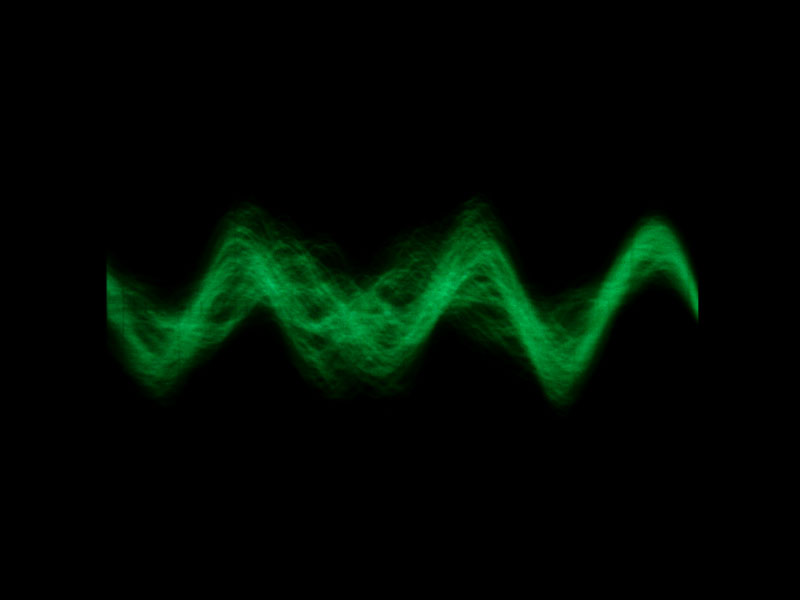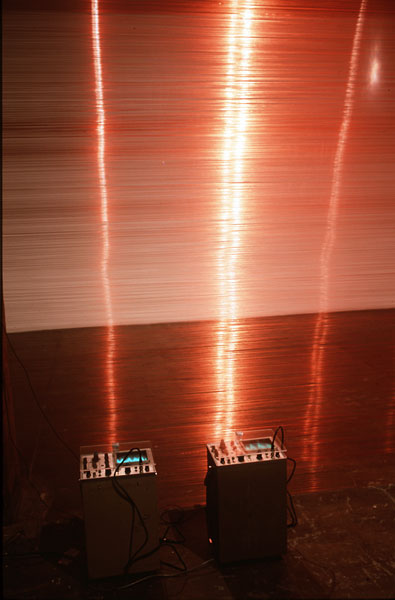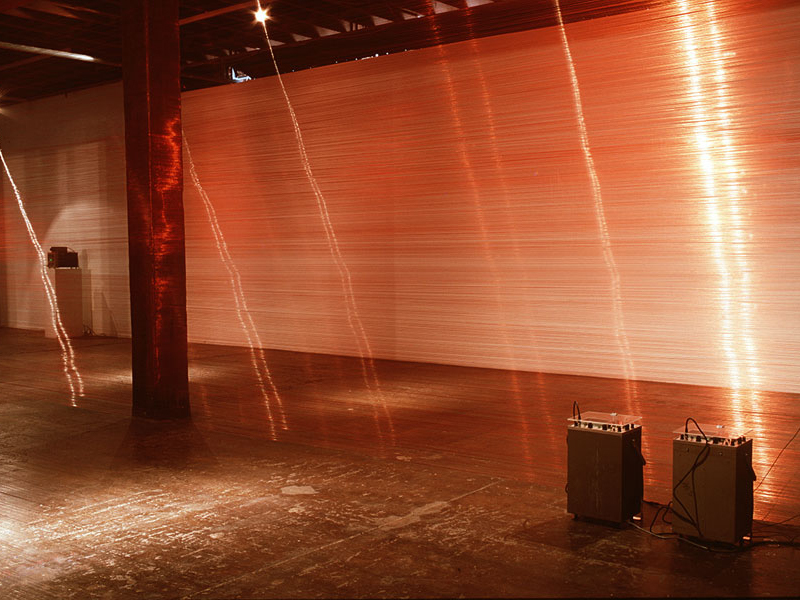Aeriology, is a large scale detuned custom built antenna that resonates to the range of radio frequencies related to it’s length, dimensions, and physical qualities. Like a classic transformer, aeriology also transforms electrical and electromagnetic activity in the room and the surrounding atmosphere into electrical activity in the wire. This activity can be translated into sound or image or can be thought about as an alternative power source, gathering energy out of the air. A kind of aerial capacitor that stores enough energy to amplify the signal it resonates to.
Hinterding’s Aeriology.
In the acoustic world of insects and animals, creature calls have assigned frequencies. Cicadas talk to one another on one frequency, frogs on another; one creature call might intersect another briefly but over time each will occupy its own niche on the spectrum. Together they create a polyphony of communication that, though noisy, isn’t noise, and though mellifluous, isn’t music.
Further up the vibrational chart, we find a similar network of calls permeating the atmosphere, wrapping us in a new atmosphere of communications, an orb of electromagnetism (em-orb). Early in the 20th century, Lee De Forest, one of the founders of radio, called it the “empire of the air;” while the philosopher Gaston Bachelard imagined that the world was enveloped by a “logosphere,” an invisible layer comprised of words, as though “locust storms of print” had swollen to a global, meteorological scale. During the 20th century, the em-orb became dense with television signals sucking everyone to the set at the same time, riddled with ricocheting tracers of military, governmental, and industrial satellites. Now, with the transmissional traffic in cyberspace, it is denser than ever. The blizzard of unseen and unfelt signals isn’t just cavorting in the clouds; it’s beaming through your skull during the most mundane mobile phone call and broadcasting a duet from your computer monitor and cpu as you boot up. At this very moment, Jerry Springer is probably racing through your thigh on the wings of a tiny television signal.
But the em-orb isn’t new. We flatter ourselves that we have invented electricity and radio, yet the airwaves have forever been inhabited by natural radio, emitted as the earth’s atmosphere is punctuated by lightning, warbled by magnetic fluctuations, and graced by every manner of cosmic radiation and wave. Perhaps the most magnificent displays are produced by the huge global events of aurora borealis and aurora australis; sparked by storms on the sun, they ultimately collapse into the briefest radio glyphs. However, there is no natural reserve; just as chainsaws cut across bird songs, so too are natural radio waves intersected by human transmissions.
The full spectrum of transmissions, emissions, and radiation are entangled in a grand mix of nature and culture in which individual signals nevertheless maintain their discrete channels: Internet lists will talk to Internet lists like cicadas talking to each other; others will just listen in. The mysterious might be heard in the formida¬ble power of the earth, the banal given voice in the day-to-day grind of commercial broadcasting. Wrapping ourselves in this atmosphere, accepting all the signals and energies it has in store, might be a means of attaining rapture, or it might be more insidious. Trapped rather than rapt, we may find ourselves unable to escape a demographic niche that belongs to some¬one else’s marketing scheme.
Artists, poets, and composers throughout the 20th century have dealt with living in the embrace of the em-orb. The composer Edgard Varese, enthusing about his (unfinished) Astronomer, imagined a kind of populist physics, complete with “voices in the sky, as though magic, invisible hands were turning on and off the knobs of fantastic radios, filling all space, crisscrossing, overlapping, penetrating each other; splitting up, superimposing, repulsing each other; colliding, crashing.”
More recently, the Australian artist Joyce Hinterding has likewise been investigating the em-orb. Her site-specific installation Aeriology is essentially a huge antenna that pulls in and concentrates the most minute, stray bits of energy and transmissions and makes them audible over several small loudspeakers. The physical construction of Aeriology is simple; its functioning and beauty are remarkable. Inside the warehouse spaces of Artspace in Auckland, Artspace in Sydney, and V2 in Rotterdam, Hinterding has cordoned off an area from floor to ceiling by winding about 20 miles of .6mm magnet wire between columns, illuminating each section with spotlights to give the effect of a space “composed” of translucence-a shining copper cube.
The huge coil throws arcs of light across the room while humming in sympathetic resonance with its electromagnetic surroundings. It functions simultaneously as an antenna, transformer, and transducer, yet doesn’t function very well as any of these alone. That’s fine. Hinterding makes no pretence of being an engineer; in fact, she delights in her antenna’s “aberrant” behaviour- the way it picks up signals from all over the spectrum, its refusal to be precisely tuned, and its obvious delirium in the thrall of energies. In the presence of such activity, surrounded by the hum of the speakers and draped in the shimmering light, it is impossible to continue thinking of the air around you as lifeless or inert.
Aeriology looks as though it could be a Minimalist sculpture, but this thing is energized. The artist explains, “The coil is a broadband, detuned antenna that resonates with a range of radio frequencies related to its length, dimensions, and physical qualities.” The sounds of these signals are heard from speakers attached to the coil, and that’s where the surprise lies. The structure attracts enough ambient electromagnetic energy to drive its own speakers. No external power source is used: Hinterding’s sound sculpture is literally plugged into the atmosphere. Thus, its magic arises from the subtle shift, as she says, from materiality to activity, from the solid to the ephemeral, and this in turn allows Hinterding to use her wayward antennae to experience the world and all its objects moving, buzzing, and resonating with each other.
The frequencies Aeriology attracts are all over the place, high, low, and in-between, pointing to the fact that this hybrid antenna is not efficient and is not meant to be. Nonetheless, it has enabled Hinterding, after years of immersion in this part of the electromagnetic spectrum, to hear frequencies in the very low range ones that rumble on the edge of audibility, overpowered by the 50- or 60-cycle noise of the electrical grid a constant reminder of the crowded human spectrum. In this region, “natural radios” created by solar flares and lightning (which strikes the earth an average of 400 times a second) manifest themselves in pinging and popping sounds. Sometimes it’s possible to detect the barely audible downturn of a “phwitt” from a “whistler;”the common term for the radio burst heard after light- ning has bounced and refracted through the magnetosphere, the higher frequencies arriving first, the lower; slower-moving ones arriving soon thereafter.
The seemingly random scattering of signals, each with its own cycle and meaning, forms a layer, a field, a signalscape that Hinterding is both personally exploring and manifesting, or as she says, “evidencing.” Wrapped in this electromagnetic world, it’s difficult to know where nature ends, and culture begins, where electronic transmissions borne of atmospheric phenomena merge with telecommunications. The benign mutterings of the ionosphere not only converse with our electronic technologies but are converted by them into what we call disturbances, interference, and interruptions.
Then, too, they can exert themselves more forcibly: enough solar flare activity can wipe out global satellite systems, crashing world stock markets; enough mobile phone emissions and, some believe, frenzied neural cells may become tumours. Such exchanges between objects and bodies point to the fact that, regardless of their constitution-celestial, meteorological, or organic-all things intermingle, transmitting minute vibrations that permeate the boundaries of skin and metal, sky and stone. Hinterding’s antenna reminds us of the fundamental resonance between objects: invisible, intangible, unpredictable, and not always sympathetic.
The blizzard of unseen and unfelt signals isn’t just cavorting in the clouds; it’s beaming through your skull during the most mundane mobile phone call and broadcasting a duet from your computer monitor and CPU as you boot up.
-Liminal Product
Artbyte September-October OO
Page 82 SOUND Music




